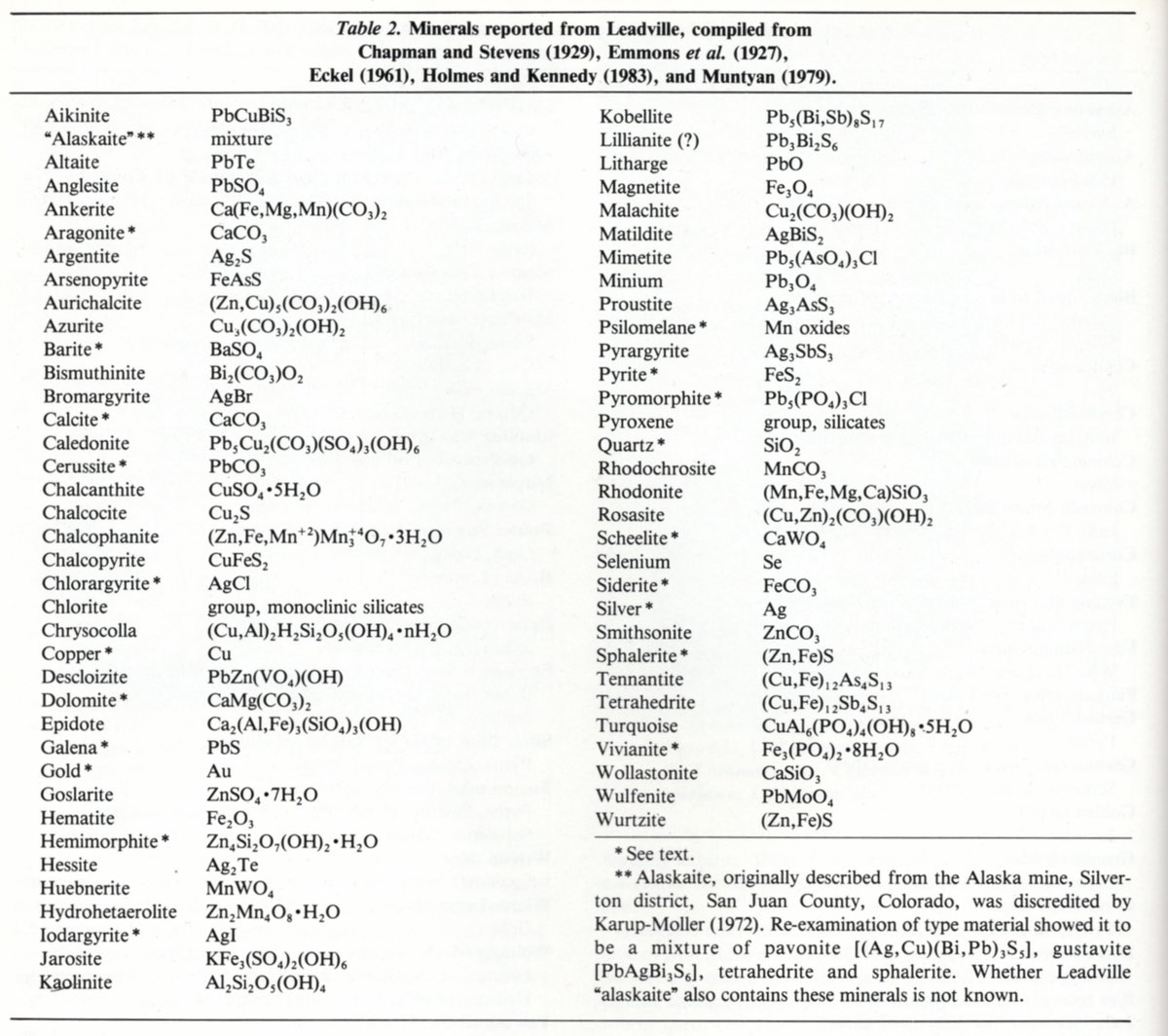Minerals
The following discussion centers on those species of most collector interest. All of the species reported from Leadville are listed on Table 2, and a few are also described in the preceding section on mines.
Aragonite
(Ca,ZN)CO3
A variety, named
Barite
BaSO4
"Some white crystals in vugs in sulfide ore supposedly were found in the Yak tunnel” (Emmons et al., 1927).
Calcite
CaCO3
“Large and very handsome rhombohedrons (of calcite) on cerussite occur in the Evening Star. Much of it occurred in a cave found in the workings of the Boarding-house shaft” (Ricketts, 1883).
Cerusite
PbCO3
“Large and very handsome rhombohedrons (of calcite) on cerussite occur in the Evening Star. Much of it occurred in a cave found in the workings of the Boarding-house shaft” (Ricketts, 1883).
A fist-size chunk of jackstraw cerussite is known [ER collection] in which crystals 1 mm by 1.5 cm are complexly intergrown. The specimen is from the Stone mine, one of Wood's and Stevens's original 1874-75 claims in California Gulch.
"It is reported that in the Morning Star and Evening Star mines there were numerous cavities in the galena which were lined with large transparent crystals of cerussite having the form of long prisms capped by the pyramid" (Emmons et al., 1927).
Copper
Cu
Flat, dendritic masses of copper occurred in the Ibex mine and as small thin flakes in the mines on Iron Hill. Although occasionally found in other localities, none was of sufficient size or form to collect (Emmons et al., 1927).
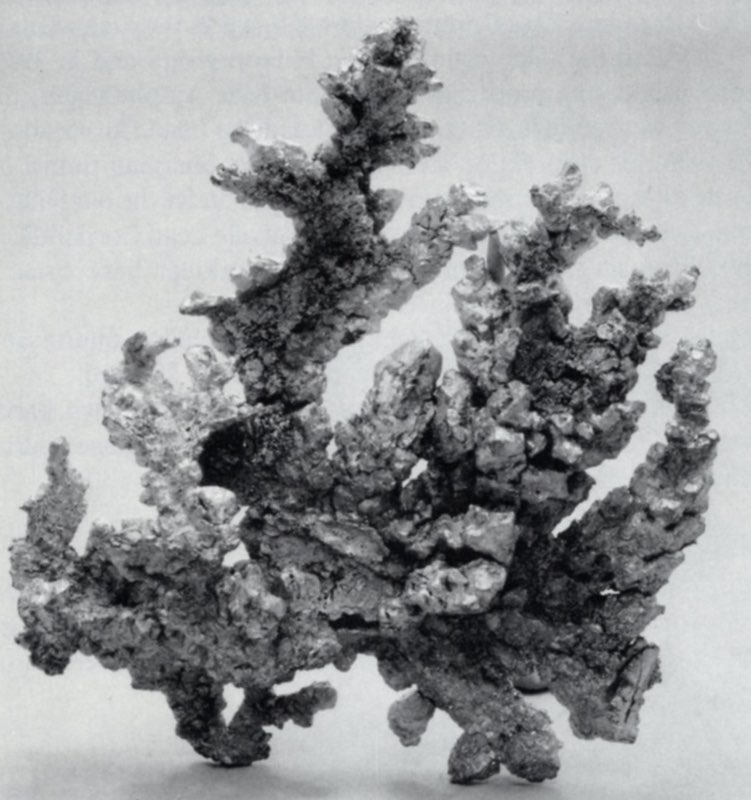
Dolomite
CaMg(CO3)2
Dolomite occurred “as white rhombohedrons lining vugs in sulfides” in many of the mines of the area (Emmons et al., 1927).
Galena
PbS
“Galena occurs mostly in granular masses, and to a minor extent as well-developed crystals lining cavities. . . . Where the galena is pure the largest crystals attain an inch in diameter.
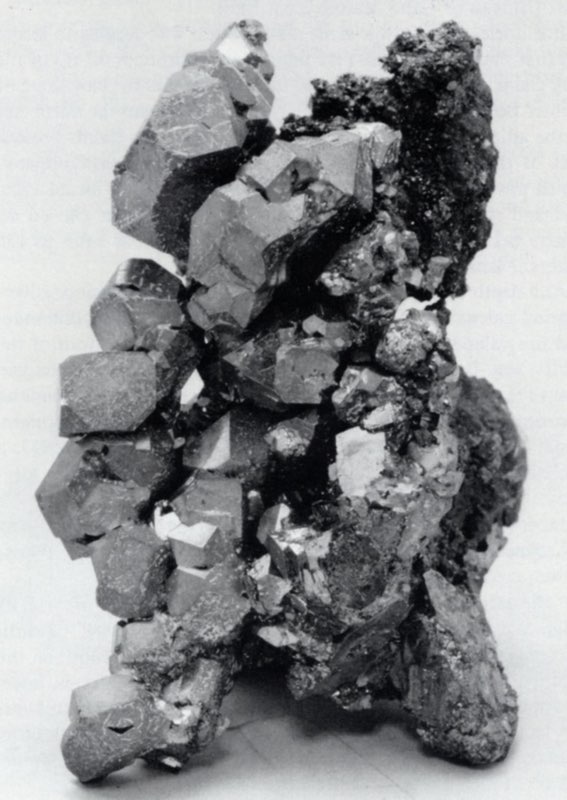
“Large fractures lined with galena crystals were observed in the Moyer, Tucson, A. Y. and Minnie, Wolftone and many other mines.
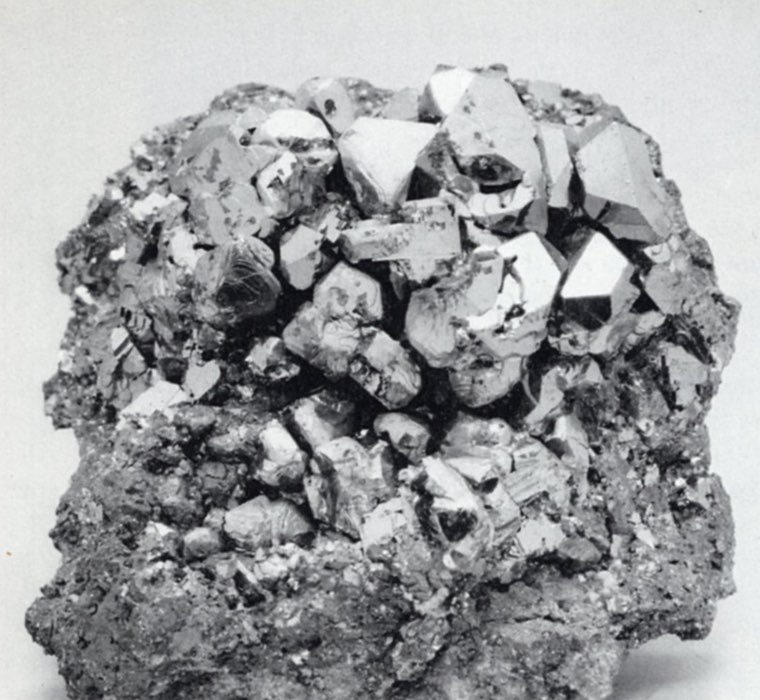
"Another variety of galena in peculiar crystal form occurs in considerable quantity in nearly all the mines, and is especially abundant in the mines of Iron and Carbonate hills and Graham Park. These crystals are brilliant and in places occur in great profusion as linings in the cavities of the ores. Many of the cubes are twinned, and some of the faces are built up by peculiar rounded irregular and incomplete accretions. Many of these accretions consist of smaller and smaller superposed layers. These layers are similar in origin to those giving the 'Gothic window effect to pyrite crystals. Some portions of the crystals, usually on the under sides next to the wall on which they are attached, are rounded and irregular, resembling semi-fused material. This appearance is not due to fusion, however, but may be interpreted as a variation of the accretionary growth just described, in which the decreasing size of the successive layers is so gradual that no lines of division can be seen between them" (Emmons et al., 1927).
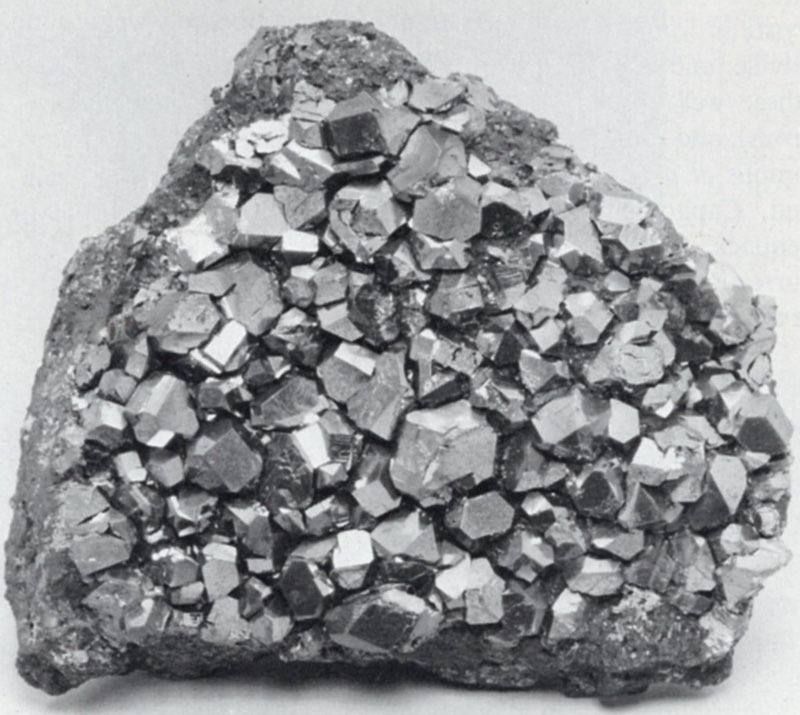
Some galena contains silver and bismuth (Chapman and Stephens, 1933).
Gold
Au
“Native gold has been found in varying quantity in many of the Leadville ores. Although most of the ore classed as gold-silver or gold-copper ore, whether primary or altered, contains gold only in microscopic or submicroscopic grains, gold in coarse flakes and wires has been seen in the enriched parts of several of the lodes and closely associated blanket orebodies in the eastern part of the district, notably in the Ibex, Garbutt, Winnie-Leuma, Big Four, Colorado Prince, Great Hope, Printer Boy and Lilian (Florence) mines” (Emmons et al., 1927).
In the Winnie-Leuma lode “some of the ore ran as high as 100 ounces to the ton in gold, and leaf and wire gold occurred in considerable quantity. The blanket ores of the Florence (Lilian) mine carried large quantities of native leaf gold on a narrow contact between the limestone and the overlying white porphyry.” Specimens of crystalline gold composed entirely of flattened octahedrons in parallel growth, associated with alaskaite (a discredited species) were reported (Emmons et al., 1927).
Hemimorphite
Zn4Si2O7(OH)2·H2O
According to Heistand, the Henriett and Maid of Erin mines produced specimens of hemimorphite (Heistand, n.d.).
“Calamine (hemimorphite) occurs typically in fine to coarse druses of white to colorless bladed crystals, or in aggregates of diverging crystal groups, which may partly or completely fill cavities. In one exceptional specimen, found ... on the dump at the Adams shaft, . . . calamine crystals are coated with minute quartz crystals. The calamine crystals have grown upon both massive and drusy smithsonite and on red and brown iron oxides and black manganese oxides” (Emmons et al., 1927).
The Field Columbian Museum of Chicago reports that some Maid of Erin ores received after the World's Columbian Exposition in 1893 contained an ocherous substance thickly coated with long, slender crystals. The crystals, determined by testing to be calamine or hemimorphite, occur in groups which were partly radiated and partly joined. The average length of the crystals is about 10 mm; they are transparent to translucent and colorless to white (Farrington and Tillotson, 1908).
In the Little Jonny hemimorphite crystals were found as diverging groups of blades associated with Leadville's only occurrence of aurichalcite.
Psilomelane
Mn oxides
Manganese oxides (“psilomelane”) occurred in both stalactitic and mammillary forms and one fine specimen can be seen in the accompanying photographs. Unfortunately, the only locality given is "Leadville."
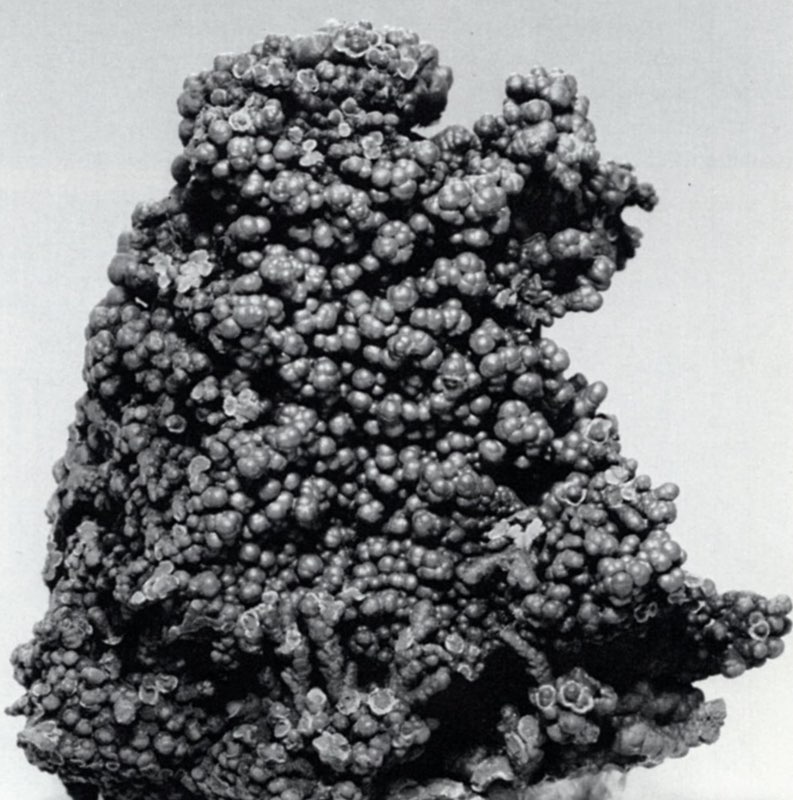
Pyrite
FeS2
Pyrite is found in some form in the majority of the mines in Leadville, and in a number of cases occurs as fine crystals. “Some of these well-formed crystals are 12-faced (pentagonal dodecahedrons), and some are cubes. All have characteristic striated faces” (Emmons et al., 1927). Pyrite was found in the Adelaide, Black Cloud, Capitol, Garibaldi, Garbutt Shaft (Little Jonny/Ibex), Greenback, Mahala, Maid of Erin, Matchless, Moyer, R. A. M. Resurrection, Silver Cord, Tucson and Wolftone mines and in the Yak tunnel.

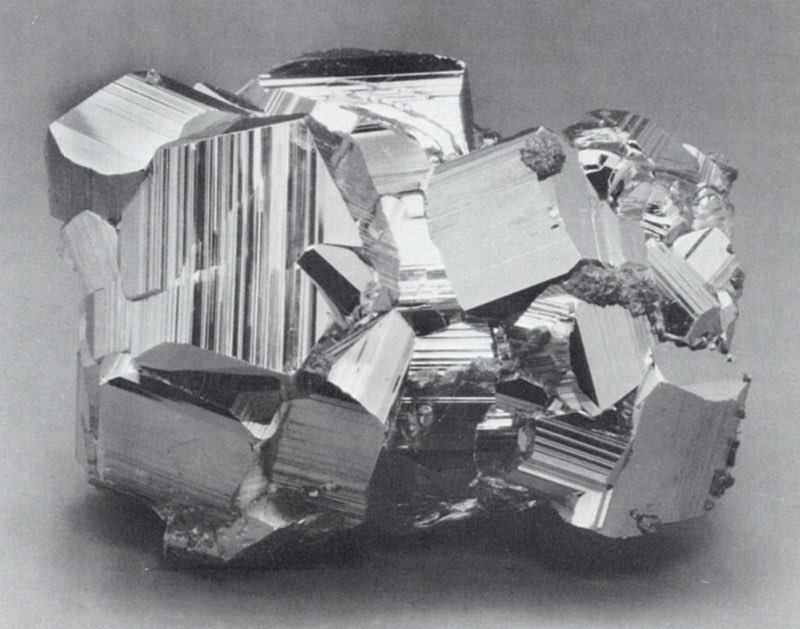
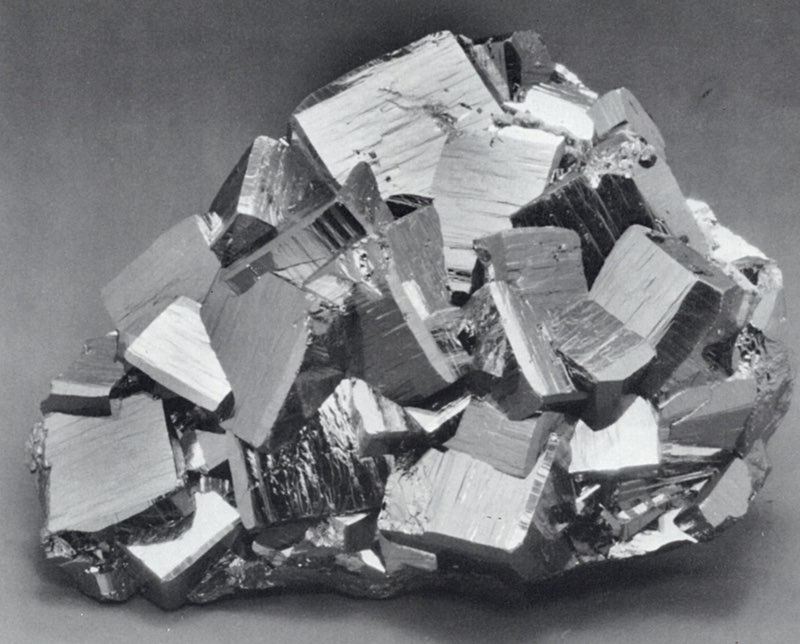
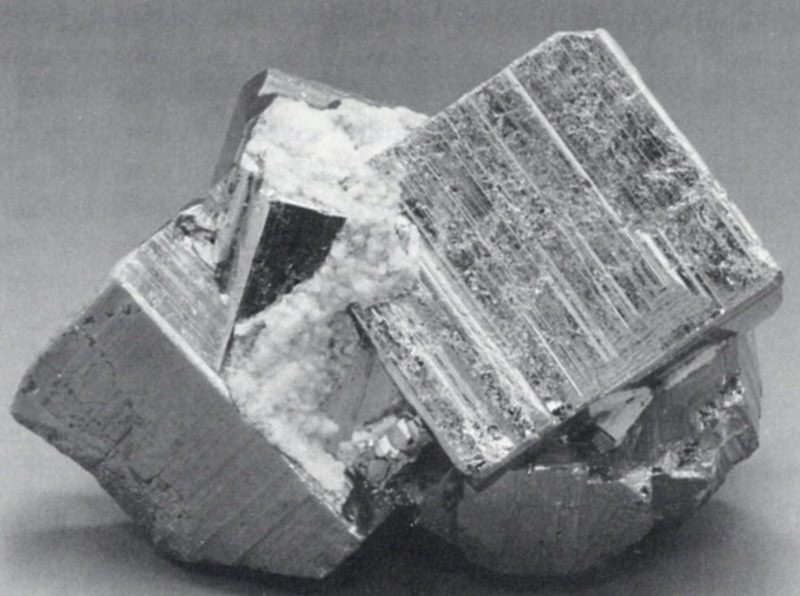
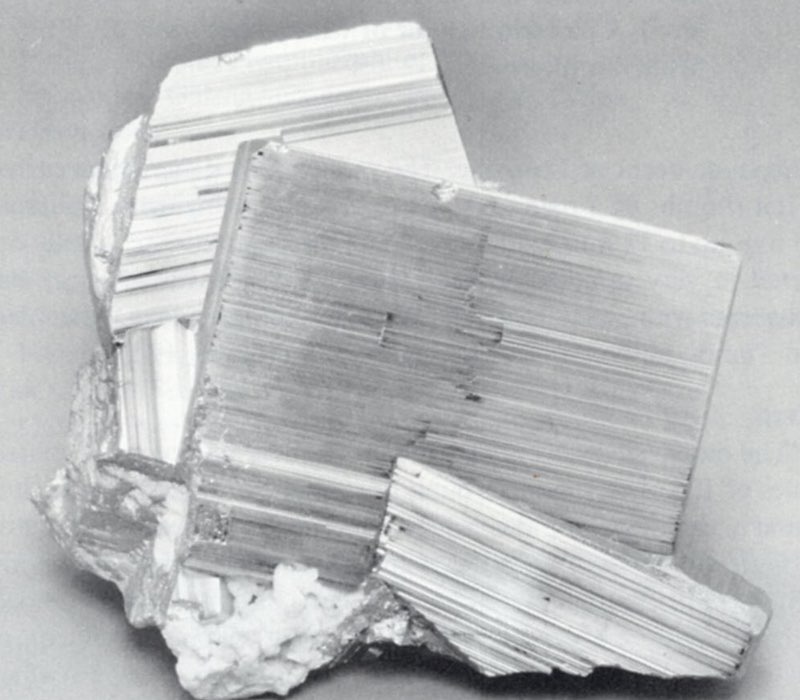
Pyromorphite
Pb5(PO4)3Cl
"Slender, tapering, yellowish green crystals of pyromorphite, as much as an inch long, are frequently found, single and as radiating clusters, in the linings of cavities in the oxidized ores of both blanket orebodies and lodes.
"Pyromorphite was also observed in the Evening Star mine” and was also reported from the Great Hope mine (Emmons et al., 1927).
Quartz
SiO2
“Very fine colorless crystals of quartz have been found coating calamine (hemimorphite) crystals in low-grade oxidized zinc ore from the old Mikado dump” (Emmons et al., 1927). Many fine specimens of blue quartz crystals with dolomite are known from the Black Cloud mine.
Scheelite
CaWO4
Scheelite has been found in the Golden Queen mine, and also in the Garbutt shaft as excellent, deep red-orange, pseudo-octahedral crystals.
Siderite
FeCO3
Both the pure siderite and siderite containing significant manganese occur at Leadville. The pure variety generally occurred as flat rhombs of a pale to dark brown color, ranging in size from 1.5 mm up to 12 mm in diameter. The manganosiderite usually occurred in very small grains and crystals, almost always gray but sometimes with a pink cast. The Black Cloud, Julia-Fisk, Matchless and Tucson all contained siderite (Emmons et al., 1927).
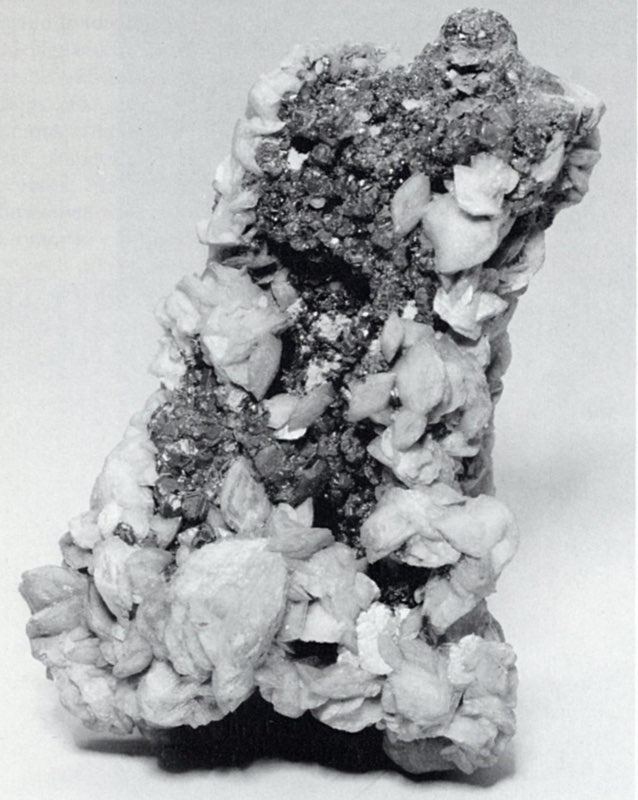
Silver
Ag
“The native silver occurs both as wire silver and as small plates, scales or flakes scattered through the gangue or country rock. It is found in cavities in sulfides, where it has probably been precipitated by reaction between the sulfides and descending waters. The wires are generally small, but some attain lengths of half an inch or more, with striations parallel to their elongations. Some specimens of siliceous ore are formed of bluish cavernous jasperoid in which plates of native silver from 3 to 10 millimeters in diameter are profusely disseminated. To a minor degree the scaly silver is partly coated with thin bluish tarnish, presumably due to the presence of a small portion of sulfide on the outside of the mineral” (Emmons et al., 1927). These plates of native silver occurred in the Coronado mine.
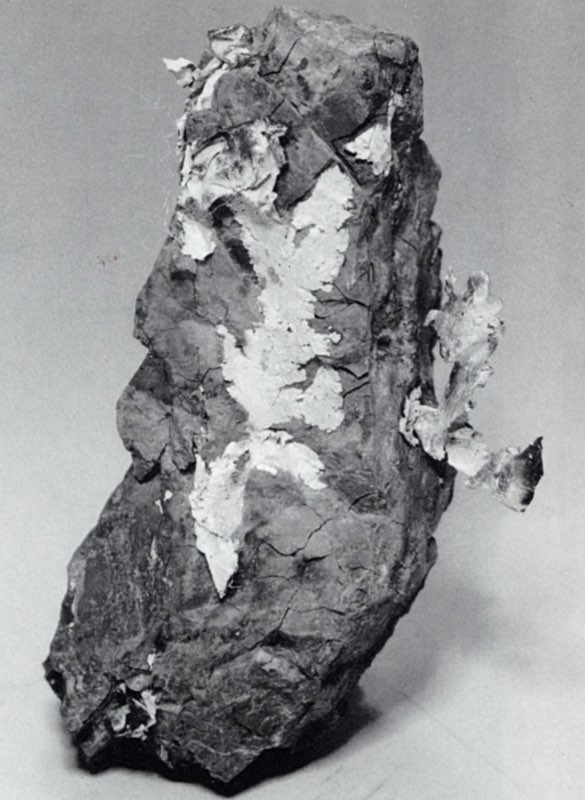
Note the interesting, ornate description by Arthur Lakes of specimens from the Colorado State Mining Bureau collection, at one time housed in the Capitol building: “A sample from the Colonel Sellers mine glistens with large galena crystals, amongst which are dark little caverns lined with perfect quartz crystals, and clinging to the crystalline walls and roof of these Aladdin grottoes, are trailing mosses and vines of silver with tufts and tussocks of mosslike silver from which depend black silver rootlets. One from the A. Y. and Minnie, Leadville, is a black rock covered with black, wriggling serpents. These silver forms are doubtless tarnished with manganese” (Lakes, 1895). Lakes' “manganese” was probably acanthite.
Lakes also describes another beautiful silver specimen “from the Maid of Erin which is a mass of black manganese traversed by narrow seams of quartz from which issue beautiful leaves of silver foil. Another specimen shows wire silver issuing from crevices and tiny caverns lined with quartz crystals resembling tangled rootlets of moss, colored almost black, these rootlets being curled like celery stalks. Another rock is gray and black with silver sulphurets in which are many little caverns lined with quartz crystals, on the bottom of which appear clusters of wriggling snakes of silver like the locks of Medusa” (Lakes, 1895).
Silver Halides
“The prevailing varieties (of silver halides present in Leadville) are the green chlorobromide embolite, Ag(BrCl) [bromargyrite), and the colorless chloride cerargyrite, AgCl (chlorargyrite), each of which contains a very small amount of the iodide molecule. Brilliant yellowish crystals along joints in lead carbonate ore were found in the Weldon mine but were not analyzed” (Emmons et al., 1927). Emmons stated that the chloriodide was also present in less quantity and mentioned minute yellow crystals of iodargyrite (Agl), in the Chrysolite mine. These were also found in the Evening Star and Morning Star mines (Ricketts, 1883).
“The mineral embolite is invariably light greenish, soft, and sectile and does not change color on exposure to light. It occurs in scales and plates, as single grains or aggregates of such grains, and as rough crystalline coatings on the walls of crevices. The crystalline structure can be seen through a magnifying glass” (Emmons et al., 1927).
Sphalerite
(ZnFe)S
“With the exception of pyrite, sphalerite was the most abundant mineral in the Leadville ores” (Emmons et al., 1927). Most commonly it was associated with pyrite and galena and ranged from a dark brown color to an almost metallic black. Some of the coarse orebodies contained vugs of twinned sphalerite. Crystals up to 13 mm were found in the Moyer, Tucson, A. Y. and Minnie and other mines on Iron Hill. The Julia-Fisk, Little Jonny, Matchless, Resurrection and Wolftone also produced sphalerite crystals.
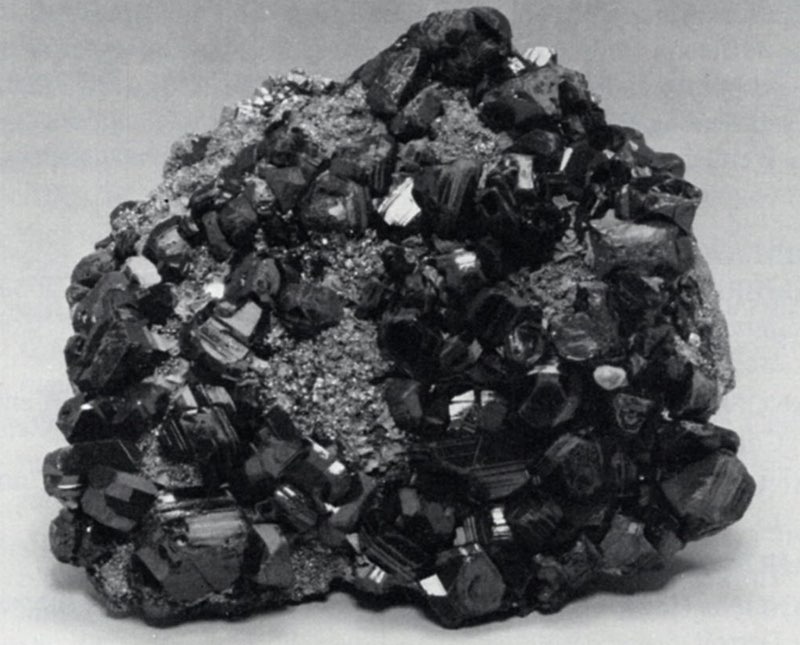
Vivianite
Fe3(PO4)2·8H2O
Another mineral which was found at least in small quantities in all the oxidized ores of Leadville is vivianite. It usually occurred as "indigo-blue to bluish green flat prismatic crystals” with striated faces. It occurred both as single crystals and crystalline druses (Emmons et al., 1927).
